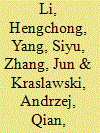|
|
|
Sort Order |
|
|
|
Items / Page
|
|
|
|
|
|
|
| Srl | Item |
| 1 |
ID:
132634


|
|
|
|
|
| Publication |
2014.
|
| Summary/Abstract |
To alleviate the problem of the insufficient reserves of natural gas in China, coal-based synthetic natural gas (SNG) is considered to be a promising option as a source of clean energy, especially for urban use. However, recent study showed that SNG will not accomplish the task of simultaneous energy conservation and CO2 reduction. In this paper, life cycle costing is made for SNG use in three main applications in residential sector: heating, household use, and public transport. Comparisons are conducted between SNG and coal, natural gas, liquefied petroleum gas (LPG), diesel, and methanol. The results show that SNG is a competitive option only for household use. The use of SNG for heating boilers or city buses is not as cost-effective as expected. The biggest shortcoming of SNG is the large amount of pollutants generated in the production stage. At the moment, the use of SNG is promoted by the government. However, as shown in this paper, one can expect a transfer of pollution from the urban areas to the regions where SNG is produced. Therefore, it is suggested that well-balanced set of environmental damage-compensating policies should be introduced to compensate the environmental losses in the SNG-producing regions.
|
|
|
|
|
|
|
|
|
|
|
|
|
|
|
|
| 2 |
ID:
088221


|
|
|
|
|
| Publication |
2009.
|
| Summary/Abstract |
As an effective measure for environmental impact associated with the waste emissions, exergy is used to unify the assessment of the waste gases of CO, NOx, and SO2 emitted from fossil fuel consumption by the transportation system in China. An index of emission exergy intensity defined as the ratio of the total chemical exergy of the emissions and the total converted turnover of the transportation is proposed to quantify the environmental impact per unit of traffic service. Time series analyses are presented for the emission exergy and emission exergy intensity of the whole Chinese transportation as well as for its four sectors of highways, railways, waterways and civil aviation from 1978 to 2004. For the increasing emission exergy with CO taking the largest share, the highways sector was the major contributor, while the railways sector initially standing as the second main contributor developed into the least after 1995. The temporal and structural variations of the emissions are illustrated against the transition of the transportation system in a socio-economic perspective, with emphasis on policy-making implications
|
|
|
|
|
|
|
|
|
|
|
|
|
|
|
|
|
|
|
|
|